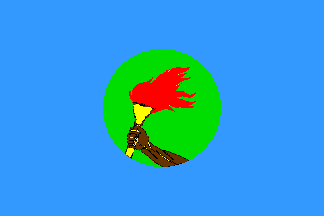 image by Ivan Sache, 31 Aug 2008
image by Ivan Sache, 31 Aug 2008
Last modified: 2009-04-24 by bruce berry
Keywords: cndp | mlc | uferi | rcd | mpr | pprd | unir-mn | national alliances party for unity |
Links: FOTW homepage |
search |
disclaimer and copyright |
write us |
mirrors
 image by Ivan Sache, 31 Aug 2008
image by Ivan Sache, 31 Aug 2008
 image by
Tomislav Todorovic, 09 Mar 2009
image by
Tomislav Todorovic, 09 Mar 2009
Here follows my contribution about a variant, possibly erroneous, of the flag of
the National Congress for the Defense of the People, the political movement (and
its militia) from the Democratic Republic of
Congo:
In Serbian edition of the "National Geographic" magazine (ISSN
1452-6751), of July 2008, as the part of the article "Who Murdered the Gorillas
in Virunga?" (Serbian: "Ko je ubio gorile u Virungi?") by
Mark Jenkins, a map was published on pp. 82-83 as an illustration of the way in
which the political and military situation in eastern DRC affects the Virunga
National Park, especially the safety of the mountain gorillas (the murder of two
groups of these animals in June and July 2007 had given the pretext for the
article). On the map, positions of different military and paramilitary forces
were marked with their flags. The National Congress for the Defense of the
People was represented with a flag very similar to the one shown on the
movements website, but the arm was yellow as well as the torch. It is yet
to be verified if this is a variant of the flag which is really used or just an
error, because no other sources seem to have confirmed it so far.
Tomislav Todorovic, 09 Mar 2009
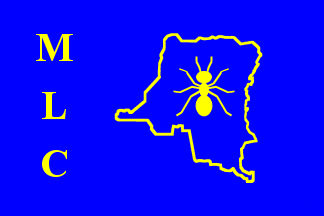 image by
Eugene Ipavec, 09 Aug 2006
image by
Eugene Ipavec, 09 Aug 2006
The flag of the MLC has changed. The flag has a blue background, featuring
the letters MLC on yellow on the left, plus the map of Congo outlined in yellow
and a yellow ant. See the MLC official website at
http://www.mlc-congo.net/
Esteban Rivera, 09 Aug 2006
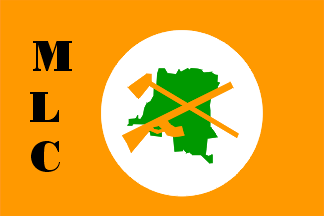 image
by Jarig Bakker, 10 Jul 2004
image
by Jarig Bakker, 10 Jul 2004
Flag of "Mouvement de Libération du Congo" (Congolese
Liberation Movement) is from http://www.managingbusiness.com/mlc/
(no longer available, ed.)
Dov Gutterman, 25 May 2002
The party's official website, provides more details on the
party and its emblem. On some pages of the website, the party is called "Mouvement
pour la Libération du Congo", but the party's statutes include only "Mouvement
de Libération du Congo".
The MLC is the result of the transformation on 05 April 2003 of the former "MLC
- Mouvement Politico-Militaire", an armed movement founded on 30 September
1998 to oppose former President Laurent-Désiré Kabila's government and
supported by Uganda, into the "MLC- Parti Politique", a political party.
The transformation is mentioned in the party's statutes (Art. 1), adopted on 29
January 2006, as well as at the party's official headquarters in Kinshasa (Art.
3), the capital of the country. The militia of the MLC, the Armée de
Libération du Congo (ALC) was (or, at least, should have been) transferred,
together with ammunition, to the regular army of the Democratic Republic of
Congo (Art. 3).
On 30 June 2003, the MLC joined the Transitional Government of
the Democratic Republic of Congo with its President, Jean-Pierre Bemba (aka the
"chairman", a relative of the former President Mobutu
Sese Seko), being appointed Vice-President of the country. In 2006, Bemba
competed in the Presidential election. His residence was attacked by the
Presidential Guard in August 2006 and he lost the second round of the election
against the incumbent Joseph Kabila with 42% of the votes. In spring 2007,
Bemba's personal guard, which was still not incorporated into the national army,
was defeated by the national army. Bemba left the country for Portugal in April
2007 and was arrested in Brussels on 24 May 2008, upon request of the
International Criminal Court.
The party's statutes describe the party's emblem as follows:
Chapter II ("On the ideology, the motto and the emblem") says: Article 9. The
emblem of the MLC is a yellow "ant" placed in the middle of a blue field of the
flag of the Democratic Republic of Congo.
<http://www.mlc-congo.net/statut.htm>
The statutes of the MLC-Mouvement Politico-Militaire, adopted on 30 June
1999, describe the emblem and the flag of the party as follows:
Chapter V. Of the emblem, the flag and the motto.
Article 8. The emblem of the MLC shall be the ant. It is the symbol of
organization, of abnegation and courage, of solidarity, of social cohesion, of
energy and of work.[...]
Article 9. The flag of the MLC shall be blue with a red diagonal stripe
fimbriated yellow and a yellow star in the upper hoist. It represents the
adherence of the Congolese people to national unity, to territorial integrity
and to prosperity. [Note the use of current national flag used in 1963-1971 and
readopted in 2006.]
[...] <http://www.congonline.com/Forum1/Forum04/MLC06.htm>
Bemba's militias are nicknamed the "fourmis" (ants), hence the prominence
of the symbol in the party.
Ivan Sache, 24 Jun 2008
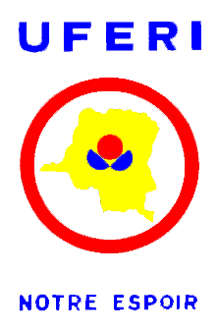 sent
by Rob Raeside, 12 Jul 2004
sent
by Rob Raeside, 12 Jul 2004
From the intermittent series on maps on flags provided by Mason Kaye.
This is the flag of UFERI, (L'Union des Fédéralistes et
Républicains Indépendants - Union of Independent Federalists
and Republicans). Seen on Belgian TV on August, 1992 (hence Zaire - not
Dem. Rep. of Congo). Outline image provided - coloured by me. I guess this
was seen as a vertical flag. Yellow map of Zaire in center. Disc
is red, half circles are blue. Red circular border. White background, blue
writing: UFERI - NOTRE ESPOIR (our hope).
Source: Michel Lupant.
Rob Raeside, 12 Jul 2004
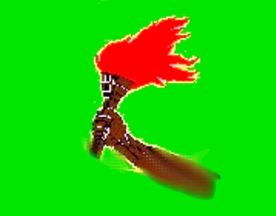 image
by Guy De Boeck, 18 Sep 2005
image
by Guy De Boeck, 18 Sep 2005
I was living in Congo when the name and flag of the country changed to Zaire. An MPR flag (the party allowed under the Mobutu regime) already existed. It had the same flag as what became the national flag of Zaire, but without the yellow circle: thus green with an arm holding a torch with a red flame. It remained flag of the party even after the national flag was changed. For as long as it remained a unique party, the cockade worn by its members was that same design : the torch on a green background, on an oval little jewel made of copper. For dignitaries, it was better carved, and protected by transparent plastic. A lot of books, reviews or papers from the Mobutu period also showed this insignia : a green band with the arm and the torch.
I cannot imagine where the so called "party flag" designed by Mr Martins
according to Mr. Bliss can be found. If that design has something in common with Mobutu and his party, then
it could only be related to the period 1965 - 1967 when
he founded an organization called CVR (Corps des Volontaire de la Republique
= Corps of Republican Volunteers). But the green and torch flag appeared
in the same time as the "Manifeste de la N'sele", at the foundation
of the MPR party. (N'sele is the name of a village where Mobutu gathered number of politicians
to prepare the MPR manifesto).
Guy De Boeck, 18 Sep 2005
The National Alliance's Party for Unity (Parti de l'Alliance Nationale pour
l'Unité) is a centrist political party in the Democratic Republic of the Congo,
founded in 2003. It has 190 candidates for the upcoming parliamentary elections
in July 2006 and has decided to support President Kabila in the forthcoming
presidential elections (see
http://en.wikipedia.org/wiki/National_Alliance_Party_for_Unity).
Article 3 : La devise du PANU est : « UNITE – LIBERTE –DEVELOPPEMENT ». son emblème est un drapeau de fond blanc, bordé de onze (11) étoiles dorées
représentant les onze provinces du pays, avec au milieu, une flèche rouge
orientée vers le haut, signe d'un mouvement ascensionnel (see http://www.panu-cd.com/statuts.htm)
which is translated as :
"a white flag, bordered with 11 gold stars for the eleven provinces of the
country surrounding a red arrow pointing upwards" (rough translation) see
it as a shield at http://www.panu-cd.com/.
"Prometevsberg", 06 Aug 2006
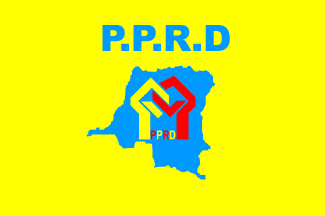 image by Esteban
Rivera,
06 Aug 2006
image by Esteban
Rivera,
06 Aug 2006
The Parti du peuple pour la reconstruction et la démocratie (PPRD)
(Peoples Party for reconstruction and democracy) of President Joseph Kabila
uses a yellow flag with the party symbol in the centre. This is a blue map image of the
country with two stylized hands in red and yellow clasping each
other. The party acronym is found between the wrists and above the symbol on the
yellow field.
"Prometevsberg", 06 Aug 2006
The PPRD was officially registered with the Ministry of the Interior by Decree
031/2002 on 02 April 2002. The statutes of the party should prescribe the
emblem of the party in Article 12, but this is left blank ("The emblem of the
party shall be...) on the online version of the statutes.
The party was founded by supporters of Joseph Kabila and members of his
government. It should follow the tracks of Patrice Lumumba, the Prime Minister
murdered in 1961, and Laurent-Désiré Kabila, Joseph's father.
Ivan Sache, 12 Aug 2006
The political party "Rassemblement congolais pour la Démocratie" (Congolese Union for Democracy) has unveiled its new flag on 23 July 2005 in the party seat, located in the city of Gombe. The flag was presented by Azarias Ruberwa Manywa, national President of the party and Vice-President of the Democratic Republic of Congo in charge of the Policy, Defense and Security Committee. The new flag of RCD is blue with a dove, a palm tree and the lettering "bonne gouvernance" (good governing).
Ruberwa explained the new flag as follows:
- the dove represents peace because " we are campaigning for peace.
We fought war for peace, this was the price to pay". "[...] The dove shows
that even in a so-called peace time, we have to search for the real peace,
that is the inner peace." Moreover the dove shall show that RCD is today
a tolerant and no longer a violent party.
- the palm tree represents democracy.
- the "bonne gouvernance" (good governance) is "a series of rules and
practices which give hope to our Republic and our citizens and determination
to our youth". "All members of the RCD who act against the "bonne gouvernance"
will be sacked.
Source: a paper by Médard Muyaya in "Le Potentiel" (Kinshasa,
28 July 2005)
Ivan Sache, 18 Aug 2005
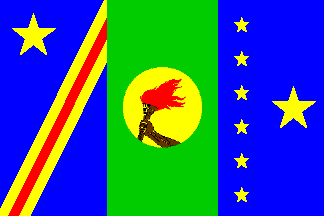 image by Ivan Sache, 24 June 2008
image by Ivan Sache, 24 June 2008
The party was founded on 10 August 2001 and officially registered by Ministerial
Decree #130 on 07 April 2005. There were no UNIR-MN representatives among the 33
candidates who competed in the 2006 presidential election.
Photographs taken in 2004 during a TV-interview in Brussels, available on the
party's website, show the party's President, Frédéric Boyenga Bofala, sitting in
front of the party's flag. This flag is vertically divided into "Congo
modern" - "Zaire" - "Congo ancien", that is the three components of the
party's map emblem (see below) transformed into a flag. The emblem and flag
reflects the party's acronym, "UNIR" which means in French "to unite". In its
statements, the party also uses the name "Congo-Zaire" for the country which is
also reflected in its flag.
The party flag shows, from left to right and arranged vertically, but with equal
yellow and red stripes; the country's current flag, the flag of
Zaire, and the second flag of independent
Congo.
Ivan Sache, 24 June 2008
 image
sent by Esteban Rivera, 06 Aug 2006
image
sent by Esteban Rivera, 06 Aug 2006
This is a flag of the Union pour la République-Mouvement National (Union for
the Republic-National Movement) (UNIR-MN) taken from the party's official website
at http://www.unir-mn.org/ It
contains the party's map emblem comprising the national flags used by the
country in the centre of a white field.
Esteban Rivera, 06 Aug 2006
 by António Martins, 22 Nov 1998, after image sent by by Nathan
Bliss, 07 Jan 1997
by António Martins, 22 Nov 1998, after image sent by by Nathan
Bliss, 07 Jan 1997
My question here is what really is this flag, because is surely not
Mobutu’s party flag. Not only it has no resemblance to the Zaire flag,
but also it features a map of Zaire / Congo-Kinshasa without the southern
secessionist provinces of
Katanga/Shaba,
Southern
Kasai and what seems to be part of Kivu,
something Mobutu would never have endorsed.
António Martins, 22 Nov 1998
It seems to me that that the map is just a distortion in order to fit
the flag (and the outspread hands). The long stretch into Zambia is there,
as well as the hiccups in the frontiers between Congo and Zambia. In my opinion it's
quite safe to assume that Nathan Bliss' image was a bit distorted and that
the real flag had the real map of Congo (or Zaïre) on it in red. Many
political flags produced by expatriates have been proved to be geographically
(or otherwise) incorrect.
Mobutu's party was the Popular Movement of the Revolution (Mouvement
Populaire de la Révolution), founded in 1967 as the principle
vehicle of the Mobutu regime. It was renamed in 1990 to Popular Movement
for Renewal (Mouvement Populaire Renouveau - MPR).
Jarig Bakker, 09 Oct 2002